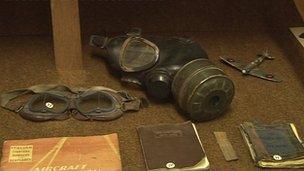Waterbeach Barracks museum 'must be saved'
- Published

Medals awarded to three Waterbeach brothers are housed in the museum
Medals belonging to three brothers killed in World War I could be among items lost to the public if a military museum cannot find a new home, its curator has said.
Waterbeach Barracks, north of Cambridge, is closing as part of Ministry of Defence (MoD) cuts, and its museum will close its doors for the final time in September.
Curator, retired Major David Hornby, has been searching for a new home for the artefacts it houses, which tell the history of the former RAF station.
Among those on show are medals awarded to Walter, Jack and Clifford Day who were born in Waterbeach and died in WWI.
"Little was known about the brothers until a local man found the medals at a Norwich auction a few years ago," Maj Hornby said.
"He purchased them for the village and they were given to the museum."
'Saving Private Ryan'
One of his colleagues researched the family's history, but the task was hindered by the fact the Day family appeared to have died out with the demise of the brothers.
"We discovered there was a fourth brother, Leonard, who had joined the Canadian forces, but I expect he lived his life out in that country, and we haven't been able to trace any other relatives," Maj Hornby said.
Today, the three brothers' campaign medals and memorial plaques - commonly known as Dead Man's Penny - given to their parents, are housed in cabinets in the museum.
Pte Walter Day, 36, of 11th Battalion, the Suffolk Regiment was killed in action on 1 July 1916 - the first day of the Battle of the Somme.
Sgt Jack Uriah Day, aged 22, of 11th Battalion, the Suffolk Regiment was killed in action on the same day.
The youngest brother, Pte Clifford George Day, of The Queen's (Royal West Surrey) Regiment, was 19 when he died of wounds received on 13 August, 1918.
"I would imagine it's probably the forerunner to Saving Private Ryan, where three brothers from the same village died at such a young age - it's tragic," Maj Hornby said.

Artefacts gathered since the station opened in 1940 are housed in the museum
As well as the medals, the museum contains photographs and other items from personnel who have served at the base since it was built in 1940.
"The station has been such a part of the village, it's not just about military memorabilia," Maj Hornby said.
"This is 72 years of the history of Waterbeach and it's important that we retain that history forever.
"It's vital that it's out on show as it's the history of the place right from 1941 and Bomber Command, through Transport Command, through Fighter Command to the present day and the Royal Engineers."
'Scattered ashes'
About 900 personnel and relatives from 39 Engineer Regiment are moving off the base and being deployed to the former RAF base at Kinloss.
The barracks site is currently being considered for development by South Cambridgeshire District Council and until those plans are finalised, Maj Hornby said the future of the museum's artefacts was uncertain.
Until a new museum site is found, the collection will be stored in the village hall.

Maj Hornby said he would continue to look for a new site for the museum's collection
"It's vital they're kept together in one place, and there's another very good reason for them to stay together in a museum," said Maj Hornby.
"Every year the boys from 514 Lancaster Squadron, who served here in 1941, return for a reunion in the museum.
"They come from all over the world and there are only 12 of them left now. They want to keep returning to the museum."
He said the barracks site also contained a memorial garden where the ashes of 13 squadron members had been scattered.
"I tend that garden, but I don't know what will happen to it or the museum when we finally leave.
"I might chain myself to the gate," he said.
- Published9 January 2012
- Published19 July 2011